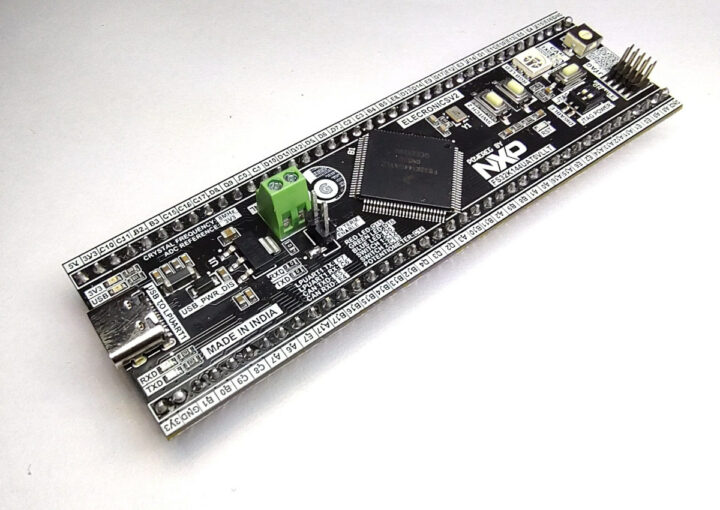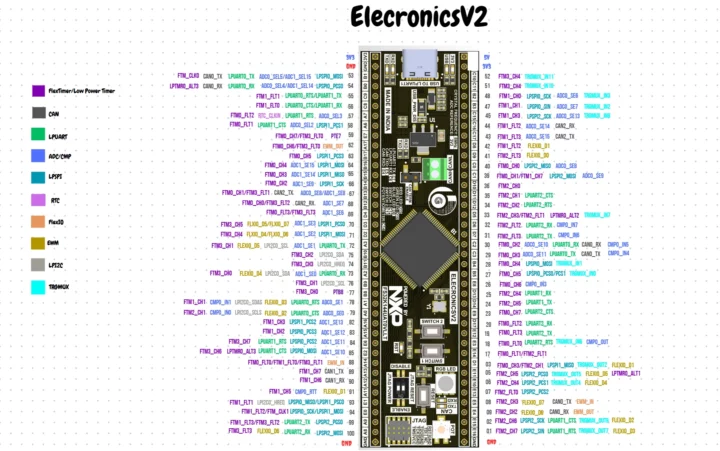ElectronicsV2 is a small development board based on the NXP S32K144 Arm Cortex-M4F microcontroller designed for automotive enthusiasts and tech hobbyists who may be interested in DIY projects such as an electric immobilizer, a CAN-based data logger, or experiment with vehicle-to-vehicle (V2V) communication
Gettobyte aims to make the ElectronicsV2 the “Arduino of the Automotive World” with affordable pricing, plenty of I/Os, a 2-pole terminal block connected to a CAN transceiver, LED and buttons, and easy-to-follow documentation and tutorials.
ElectroncisV2 specifications:
- MCU – NXP 32K144 32-bit Arm Cortex-M4F microcontroller @ up to 112 MHz with 512KB flash, 64KB SRAM, 3x FlexCAN interfaces in LFQP100 package
- CAN Bus – 2-pole terminal block connected to TJA105 CAN transceiver
- USB – 1x USB-C port for power and serial console
- Expansion – 2x 40-pin GPIO headers with CAN Bus, LPUART, ADC, LPSPI, FlexIO, EWM, LPI2C, TRGMUX
- Debugging
- Onboard UART for debugging via USB Type-C cable
- 10pin JTAG-SWD connector for JLink/SWD debugger (JLink V9)
- Misc
- Onboard RGB LED
- TX-RX LED indicator pins for onboard UART and CAN communication
- Power LEDs
- Two push-buttons
- Variable potentiometer connected to ADC
- Onboard 8 MHz crystal oscillator
- Reset configuration DIP switch (JTAG/External/USER)
- Power Supply
- Input – 5V via USB-C port or JTAG
- Output – 3.3V and 5V DC output on GPIO headers
- Dimensions – TBD

Gettobyte explains the ElectronicsV2 board is programmable in C using NXP Semiconductor’s S32 Design Studio based on the Eclipse IDE, and highlights support for the Autosaur (AUTomotive Open System ARchitecture) standard through the Autosar MCAL SDK from NXP.
The company/developer provides a getting started guide and a user manual on the product page, and has also uploaded some video tutorials on YouTube.
The ElectronicsV2 board looks like a cost-down version of the official S32K144EVB development kit ($105). It is sold for $50 on the Electronics Infra store and shipped from India since it is where the board has been designed and is being manufactured. For reference, the S32K144 was introduced in 2017, and while it’s an inexpensive way to get started, some projects may benefit from the new and more powerful NXP S32K344 Arm Cortex-M7 automotive general-purpose microcontroller that features more CAN FD interfaces (6x) and a 100BaseT1 single-pair Ethernet interface.

Jean-Luc started CNX Software in 2010 as a part-time endeavor, before quitting his job as a software engineering manager, and starting to write daily news, and reviews full time later in 2011.
Support CNX Software! Donate via cryptocurrencies, become a Patron on Patreon, or purchase goods on Amazon or Aliexpress






Should’ve added an onboard MicroSD card slot and it would’ve been perfect.
Interesting.
I’ve just started routing a similar board with a smaller version (48pin) of the same micro.
But mine is intended to run at up to 150°C, so no USB, no LED, because you don’t get components that will withstand that temperature.
I’ll have CAN though, because CAN transceivers you can get for 150°C.
BTW: Don’t get fooled by the word “Arduino”. This is not an Arduino compatible board.
There’s no Arduino bootloader for this chip family, and no Arduino core, therefore you won’t be able to develop software and flash the board using the Arduino IDE.
You need the (Eclipse based) IDE from NXP, or one of the many commercial ARM IDEs, and a USB JTAG adapter, like the Segger J-Link (or clone), or something gdb compatible (+ a lot of manual configuration).